It’s awesome to be Canadian. We are a country that gets to enjoy skiing, maple syrup, politeness, and excellent credit card rewards programs.
In fact, I’d argue that the Canadian Miles & Points scene is one of the best in the world, especially given how easy it can be for us to sign up for our American cousins’ cards.
This brings up another quandary, though: how can we best pay off our USD-denominated cards in their native currency, and perhaps optimize our USD spending money for any trips to the US while we’re at it?
Today, let’s take a look at five methods to get American dollars at a great exchange rate.
Wise
I’ve written about Wise before because their prepaid Visa card has been a great addition to the Canadian foreign exchange retail space. However, it’s not the prepaid Visa I’m super interested in today; it’s Wise’s international transfer services.
Wise openly publishes its exchange rates, which are some of the most competitive on the market, as well as an historical log of the Canadian dollar’s performance versus its American counterpart. This makes it one of the easiest ways to see what a good USD exchange rate ought to look like.
When you’ve made up your mind that it’s time to transfer, simply log in to the app or online. You can add your USD bank account down south as a recipient, and send cash to it easily and directly.
Just select how much money you wish to transfer, either directly from your bank or from funds which you’ve loaded onto your Wise Prepaid Visa.
Be aware that as per the chart above, you’ll be subjected to certain fees on Wise’s end.
Those fees are how they make their money, and the cheapest option will always be transferring from your bank account through Interac or direct debit versus using a Visa debit or – heaven forbid – credit card for the transaction. And because Wise codes as cash advance on all major issuers, it’s never recommended you use a credit card.
Still, at $1,000 (CAD) for $738 (USD), Wise is perhaps the most competitive USD exchange rates that’s widely available in the Canadian market.
Once you’ve hit send on your transfer, you’re all done. Wait a few business days for the funds to show up in your American cash account, but be advised that historically Wise has been slower for me than other forms of online transfer.
What you sacrifice in expedience, though, you certainly make up for with a good deal.
KnightsbridgeFX
The next method might stink a bit of the stone age due to the fact that it will require you to (gasp!) pick up the phone and call a trader.
But I can promise you that the person on the other end isn’t trying to sell you penny stocks from within a sweltering boiler room – they’re just trying to help you offload your CAD for foreign currencies.
The company I’m referring to which uses these ancient-seeming practices is KnightsbridgeFX, who can be reached via their call centre at 1 (877) 355 5239. Before thinking about completing a trade, let’s take a look at their stated exchange rate for our example value of $1,000 (CAD).
At a net of $744 (USD) for $1,000 (CAD), perhaps the inconvenience of calling is not a bad idea. Just remember that KnightsbridgeFX does not post its rates for every currency it trades in online, and those rates you do see in promotional materials can be subject to change. The only sure way to get a set quote is by calling in.
This being said, opening a KnightsbridgeFX account does require some effort. As a federally-regulated financial institution, you’ll have to pass fairly thorough Know Your Customer (KYC) verification before being granted an account capable of trading.
This will require you to upload your driver’s license or passport in order to open your account, as well as verify your source of funds. Every single new customer is scrutinized by real human beings to protect against fiscal impropriety.
When your account has been opened, you’ll be given a number and permitted to begin purchasing USD. Have your American banking information ready, as they’ll need it to complete those transfers down south.
Norbert’s Gambit
Do you like stocks that take rocket emojis to the moon? Well, that means you’ve probably heard of trading accounts.
Any Canadian citizen or permanent resident with an established credit history should be able to open a personal trading account. Several types of accounts, such as cash accounts whose profits are taxable, or Tax-Free Savings Accounts to make those stock-pick chicken tendies you always craved, are available.
As always, opening such an account is a very personal decision. This article is not meant to be financial advice, but it is posted here for informational purposes. Consult an accountant prior to opening or contributing to a trading account should you have any doubts about its effects on your personal financial situation.
That being said, if you have a trading account, then it is possible to engage in a classic Canadian trick: Norbert’s Gambit. This trick is named after its inventor, Norbert Schenkler, who discovered it in the early days of online stock picking.
Let’s use Questrade, for example. There may be other platforms you can use for this transaction, but this is the one that’s most famous for making the procedure simple.
- First, deposit some Canadian dollars into your account.
- Once the funds have cleared, go and purchase the exchange-traded fund (ETF) DLR.TO. Divide the number of Canadian dollars you wish to convert by the price of the ETF, which is sold in CAD, and ensure you purchase in a whole number (this is so you avoid any nasty fees incurred by buying fractional shares).
- Once you’ve purchased the DLR.TO, go to Questrade’s customer service chat.
- After passing customer verification with the chat agent, request that they journal your shares as DLR.U.TO. This is the same ETF as the previous one, except denominated in USD instead of CAD.
- Then just wait about 2–5 business days, and you’ll see the new shares in your account.
- Sell the shares, and voilà, you’ve turned your CAD to USD.
You could also choose to call or email Questrade to complete this process, but I find these to be too slow for my impatient taste. However you choose to complete the procedure, add your USD bank account to your Questrade and withdraw funds whenever ready.
Due to the time involved in this process, my preference for doing it would only be when transferring large sums of money across the border.
Your Bank’s USD Exchange Account
Sometimes, simplicity is the spice of life. Before we even get into the nitty-gritty of using your bank’s in-house exchange system, I want to warn you: this will not be as good a value as the other methods I’ve mentioned.
However, there won’t be Norbert Gambit’s complexity, KnightsbridgeFX’s phone conversations, or Wise’s at-times tedious delays. Everything will be quite simple, and what you sacrifice in cash value, you’ll get back in rapidity.
Let’s take a look at Simplii Financial’s Global Money Transfer program (which is identical in rates and speed to those of Simplii’s parent company, CIBC).
You’re getting $719 (USD) for $1,000 (CAD). Ouch. That’s $25 (USD) less than KnightsbridgeFX and $19 (USD) under Wise’s quote.
The good news is that the USD will be credited fast – my money transfers have shown up in my US bank account within 1–2 business days. In the past, I’ve also transferred from my Canadian BMO account to my US BMO Harris chequing account, and the transactions would post within hours!
While not the best option, this is often the fastest and involves the lowest amount of interaction. If you bank with CIBC or Simplii Financial, you can also take advantage of the fact that they occasionally run promos for $50-75 (USD) cash back for making a global money transfer over $100 (USD). Not too shabby.
Withdraw from an ATM
Within the Miles & Points community, it can often be verboten to even mention the dread name of that forbidden green substance…
I’m referring to cash, which is no fun when combusted. Sometimes, a traveller will need it. In such situations, it can be tempting to go and exchange currency or attempt to find some other way to get American dollars.
However, one of the best methods available to you if you have a Canadian debit card on you is to simply withdraw money from an ATM.
While you may be dinged a foreign ATM fee by your bank, and possibly another by the machine itself, you’ll get a spot exchange rate that isn’t designed to fleece you (assuming, of course, that you’re using a device from a reputable financial institution, and not a 7-Eleven in the bad part of town).
While this isn’t an ideal situation, it’s a much better idea than purchasing USD on a credit card or exchanging your CAD at a booth when you’re abroad.
In fact, there are some banks that positively encourage it. As members of the Global ATM Alliance, Scotiabank and its free junior partner Tangerine have a reciprocal no-fee agreement with Bank of America, the largest consumer bank in the United States.
How about the exchange rates?
Below, you can see the current spot rate for transferring CAD to USD within Tangerine’s USD Savings Account. This rate works out to $732 (USD) for $1,000 (CAD).
You can also withdraw directly with your CAD-denominated Scotiabank or Tangerine account and receive the spot rate minus a 2.5% standard foreign exchange fee automatically deducted.
For example, the day’s spot rate (that you can look up on Google) is $745 (USD) for $1,000 (CAD). With the 2.5% foreign exchange fee automatically deducted, you’re looking at getting around $726 (USD) for $1,000 (CAD).
But if you’d rather not open an account with Scotiabank, Tangerine, or one of the major banks, you always can get yourself a no-fee card with one of the non-mainstream players. Among those offering them are EQ Bank and Wealthsimple.
Their respective cards don’t charge any fees from their end — not even the pesky 2.5% foreign exchange fee. However, you’d still be dinged by the ATM you’re withdrawing from, and in the US, fees are around $2-4 (USD) per withdrawal.
Using the $745 (USD) for $1,000 (CAD) spot rate above, you can get $742 (USD) for $1,000 (CAD), assuming that the ATM charges you a $3 (USD) fee for the withdrawal.
But be sure to decline any conversion the may ATM offer. This racket is called dynamic currency conversion (DCC), and you’d surely be getting a bad marked-up rate.
If stuck in Philadelphia attempting to buy a cheesesteak at a cash-only joint, I know which card I’d reach for at the bank.
Conclusion
In a marketplace with this many options for converting your Canadian dollars to their southern counterparts, it can be a bit confusing to know where to begin.
I hope that today I’ve shed some light on the various methods available to us, whether it’s for paying off our US credit cards or simply gathering some spending money for our trips across the border.
Personally, I tend to use Norbert’s Gambit for large transactions, Wise for daily banking needs, and my banks’ exchange options for fast turnaround. I’m looking forward to using KnightsbridgeFX more in the future, as my account there is new.
Until next time, may your exchange rates be excellent.


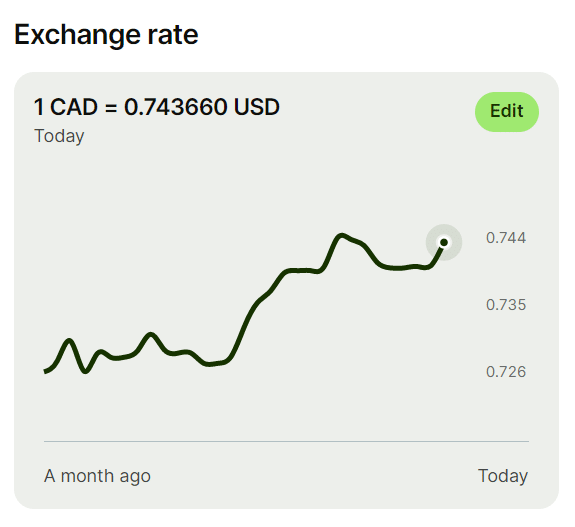
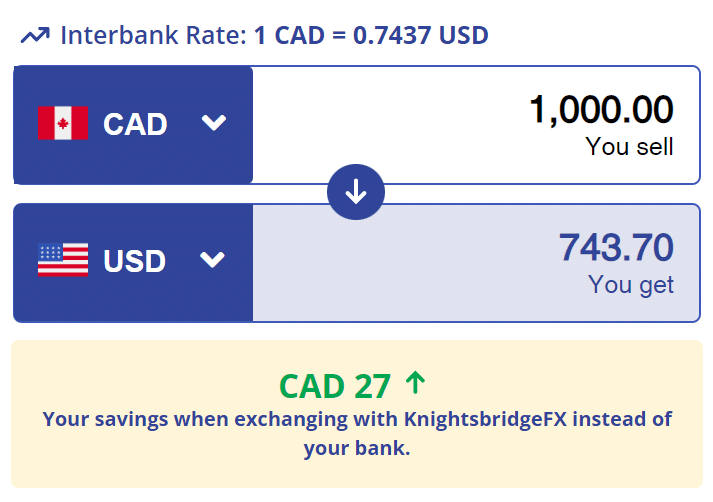

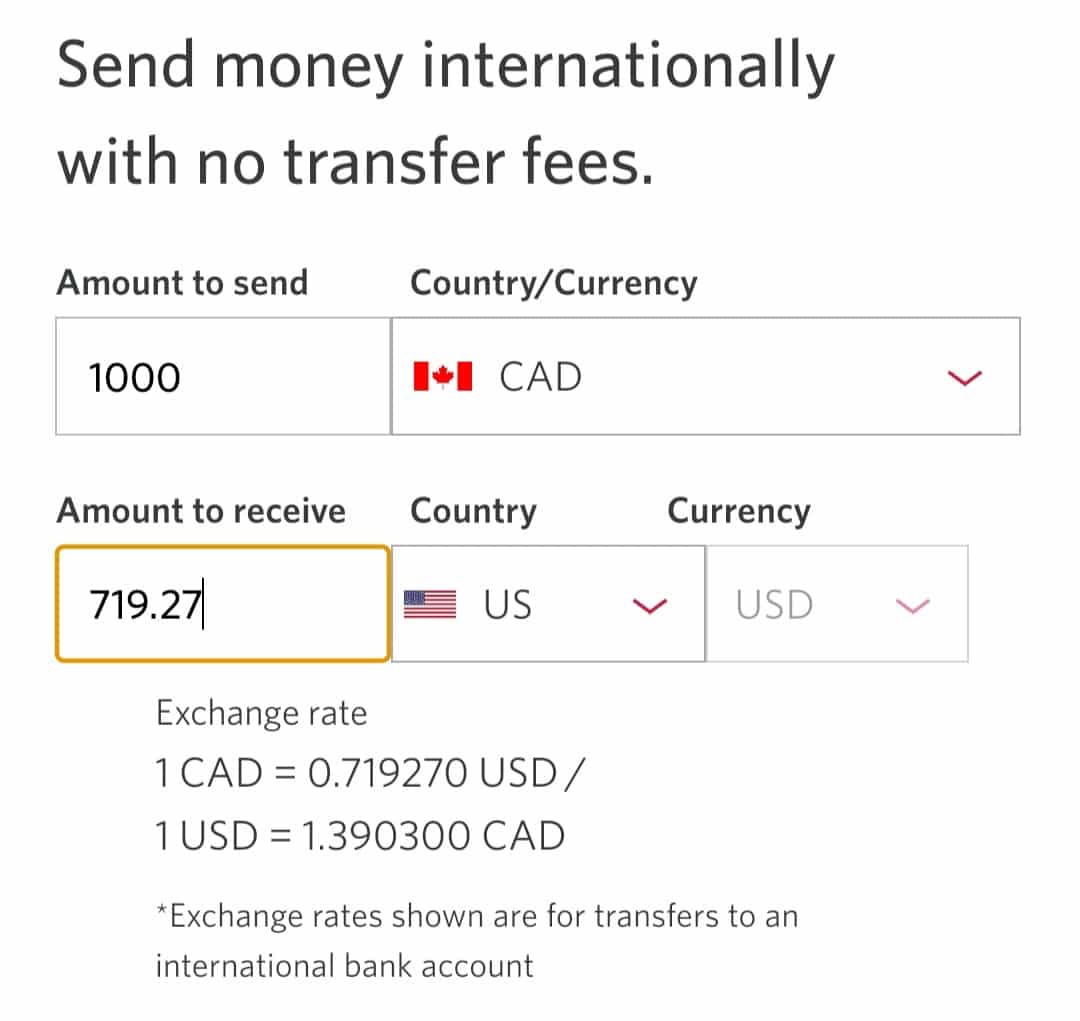
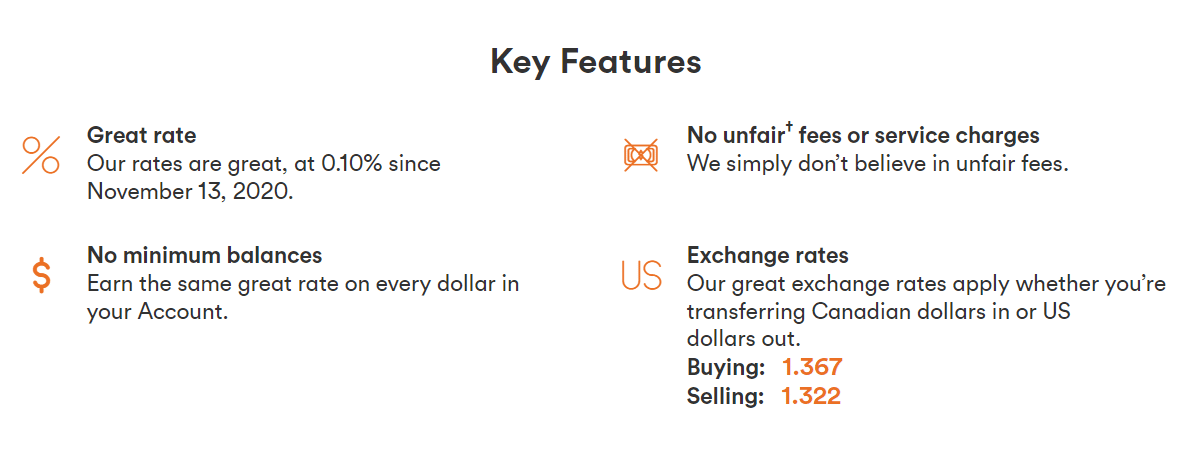
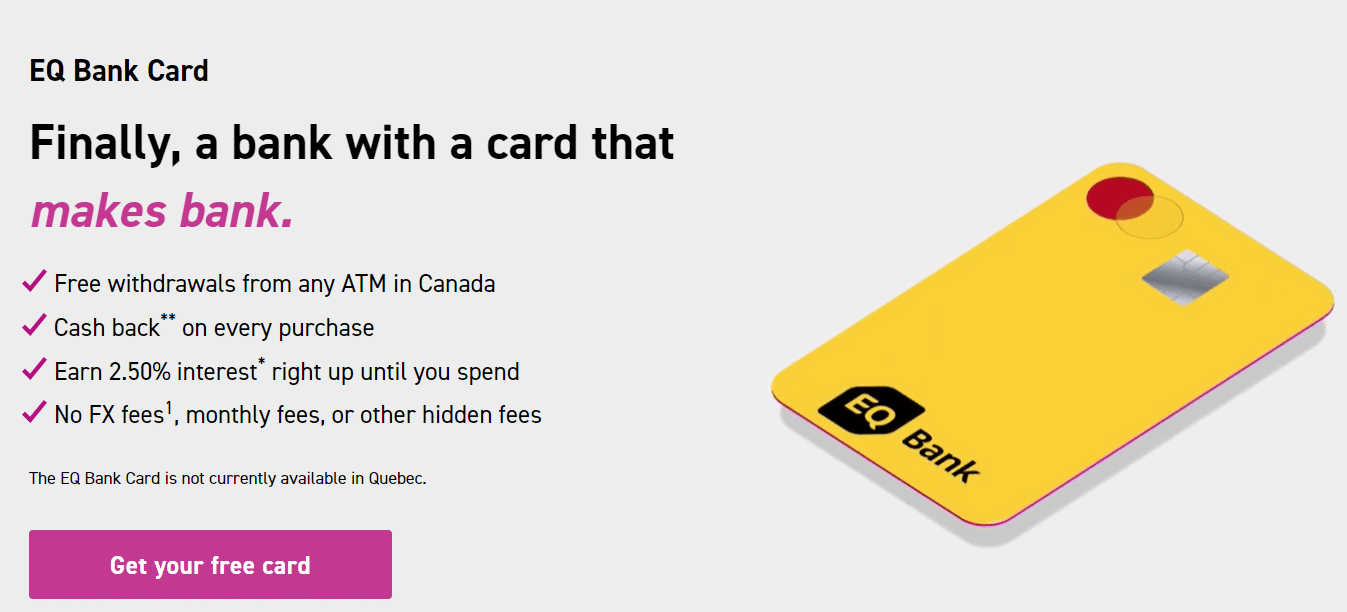









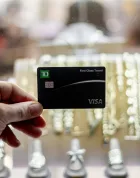
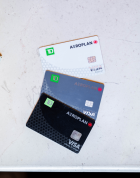


I recently tried Knightsbridge but the problem is you can’t pay them electronically, you have to visit your bank and send them a draft! The rate at xe.com is nearly as good and it can be done without the hassle.
In my view there is a sixth way, which some might prefer over all the methods cited in Kirin’s list. I know I prefer it. RBC offers preferred exchange rates to their Direct Investing Customers, on par with WISE’s rates. But your money moves in realtime when you click, without delays and without third party involvement. To enjoy WISE-like rates at RBC you must have the following from RBC: a Canadian chequing account, a Canadian USD$ account (currently $2.00/mo), RBC Cross-Border Banking Package (currently $39/year), RBC Direct Investing (with CAD$ and USD$ margin accounts) (currently free). Want USD$? Move your Canadian dollars into the Investing account, convert to USD$ inside the investing account, move the money out again, to the Canadian USD$ account. Now your USD$ are sitting in your USD$ bank account in Canada. Using “Transfer Cross-Border” feature, move the money to your Checking account in RBC Bank USA. This step doesn’t “convert”, it just moves your USD$ 1:1. All this can be performed in one Online Banking session (during market trading hours) in front of your computer, in about 3 minutes, resulting in USD$ in your Checking account in USA, ready to pay your USA card accounts. RBC Direct Investing doesn’t get upset if you never buy stocks and if you consistently use this method for foreign exchange, as I have for more than 5 years. I check repeatedly to confirm they are matching WISE’s competitive exchange rates and it’s always the same.
We currently have the reverse situation. We have bank accounts both in the USA and Canada and would like to transfer/convert some money from US (USD) to Canada (CAD). Should we open a Wise US or Wise Canada account for this operation. Both seem possible. Does it make a difference? Can anyone advise?
So I’m seeing the cost of a share of DLR.TO at $12.78 , whereas the simultaneous actual USD:CDN rate shown on my Apple Stock app is 1.272. Does this imply a fixed 0.6% markup on the exchange rate using The Norbert’s Gambit method with this avenue? Not bad but where I buy my currency the standard markup is a little lower usually.
If you have a bank brokerage account, you can request moving from a CAN cash account to USD cash account. The rates are much better than using a retail branch
A phone call can avoided with KnightsbridgeFX. You can book your currency trades via a chat window on their website.
Compare everything in the form of commission fees or spread. Bank in house average is 3%.. I used Knightsbridge for years and negotiated a commission of 0.6%… Yeah hated calling in and during banker hours. XE was next. More flexibility. Use the app any time of the day. Negotiated a 0.58% rate. Now i use Wise for smaller transfers (<15k as its gonna be a wire above that)…. Wise is almost on par with XE.
Speed… In bank? Instant.. Knightsbridge is 4-5 days. XE is 3-4 days. Wise. Instant (and cheaper) if just transfer to use on the card. 8-11hrs if used as a transfer service as the others.
You should definitely check out Interchange Financial. They have a much better exchange rate than Knightsbridge on CAD to USD for both electronic and cash conversion (they also do cash for all other currencies and they have it available all the time – no need to book in advance like the banks). Live exchange rates for all currencies are published on their website. They have multiple locations in the Toronto area but also ship all different kinds of foreign currencies anywhere in Canada for free insured by Canada Post. By far the best currency exchange service I ever experienced in Canada is Interchange both for small amounts and travel needs and also large converts for purchases in the USA.
Thanks for the heads-up, I’m going to try their home delivery service for cash and might write it up. Their inventory for cash is better than most brick-and-mortars I’ve seen so looking forward to giving it a shot.
Your article missed a much better and easier way to convert CAN$ to US$ every month or as needed basis. Key is to have a US bank account.
Canadian Snowbird Association transfers millions of $ on a monthly basis for its members at a rate that is much better than the 5 you have mentioned in your article.
thanks. i had been using my bmo cad chequing to transfer to usd savings to global transfer to bmo harris acct in usd to pay my amex brilliant. getting shafted on the currency conversion. tried wise this month. it was less complicated and cheaper. all these other ideas sound more complicated. im all for less complicated and cheaper
Thanks for the heads-up
However…
1) Membership isn’t free
2) You have to rely on whatever CSA is doing or approving. As you said, it’s a monthly basis – not really that convenient
Seems like a lot of work for literally a few dollars!!!! Unless I am buying $50K it isn’t worth the hassle to worry about $8-10 on $1000.
Just an FYI that Questrade doesn’t do fractional shares. Those “nasty fees” you’re referring to are actually ECN fees charged by the exchange. You can find more info about ECN fees, and how to avoid them, on the Questrade website here: https://questrade-support.secure.force.com/mylearning/view/h/Investing/ECN+fee+guide/
Knightsbridge is the best. You call, you get the paperwork with the guaranteed exchange amount possibly while you are still on the phone, sign it, send a jepg back and in a few business days you have the money. Larger amounts of money, thousands and thousands, get better rates. Initial set up is easy and future transactions are even easier as you will have an account. Nice thing is that someone on the other end will literally walk you through the process if you have never done anything like this before.
The best? Phone? Sign “paperwork”? Send a jpeg? Wait for days for your own money? What makes Knightsbridge “the best”?
Exactly! too much hassle for an OK rate and defiantly not the best. There are much better options in Canada than the ones listed
You should look into the crypto.com prepaid credit card. A massive unadvertised benefit of it is that you’re able to charge it in CAD and use it in the US while gaining 2% cash back AND getting zero currency conversion fees/markup.
I get the same rate as Wise, using RBC Direct Investing. Transfers from my chequing account to my RBC DI margin account are instantaneous. Then, the transfer from my CAD margin to my USD margin is instantaneous during market open hours. The transfer from USD margin account back to the bank (my in-Canada USD chequing account) is also instantaneous within market open hours. Finally the “Cross-Border Transfer” from “chequing to checking” is, you guessed it, instantaneous. Rate is within a tenth of a percent of Wise’s rate, every time. And my money never goes outside the institution where I do all my banking.
+1 for Wise from me, good for small transaction (a couple thousands, still not rich enough to buy a condo sadly). Takes about 1 day from my Canada bank account to Capital One US bank account (also highly recommend Capital One checking account: no min, no fee, just leave it open)
I have used KnightsbridgeFX to purchase my condo in Florida and nothing else came close to them by far
4b) If you’re staff or know someone that works at a bank, take advantage of their staff exchange rate, which is basically spot. Blows all other options out the water
I can confirm Thats not true, i get the same rates as someone who has a premium account if not worse
You work for the wrong bank then. Switch to a blue one
Great idea